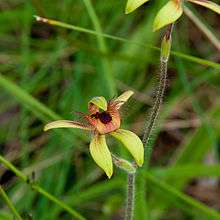Caladenia discoidea
Caladenia discoidea, commonly known as the dancing spider orchid, antelope orchid or bee orchid is a species of orchid endemic to the south-west of Western Australia. It is distinguished by its horizontally arranged flowers and unusually short sepals and petals.
| Dancing spider orchid | |
|---|---|
 | |
| Caladenia discoidea growing near Bertram | |
| Scientific classification | |
| Kingdom: | Plantae |
| Clade: | Tracheophytes |
| Clade: | Angiosperms |
| Clade: | Monocots |
| Order: | Asparagales |
| Family: | Orchidaceae |
| Subfamily: | Orchidoideae |
| Tribe: | Diurideae |
| Genus: | Caladenia |
| Species: | C. discoidea |
| Binomial name | |
| Caladenia discoidea Lindl. (1840) | |
Description
Caladenia discoidea has a single leaf, 8–18 mm (0.3–0.7 in) long, about 8 mm (0.3 in) wide and hairy on both surfaces. The flower stem is 90–450 mm (4–20 in) long and bears 1 to 4 flowers, each 20–30 mm (0.8–1 in) long and wide. The flowers are oriented horizontally, are yellow and green with red stripes, have very short petals and sepals and a rounded, fringed labellum with dark calli. Flowers appear between August and early October.[1][2][3][4]
Taxonomy and naming
Caladenia discoidea was first described by John Lindley in 1840 in A Sketch of the Vegetation of the Swan River Colony.[5][6] The specific epithet is "from the Latin discoideus (rounded blade and thickened margin), alluding to the rounded labellum shape".[2]
Distribution and habitat
The dancing spider orchid is widespread in the drier areas of the south-west between Kalbarri and Israelite Bay, growing in woodland, sometimes on the edges of salt lakes.[1][2] It occurs in the Avon Wheatbelt, Esperance Plains, Geraldton Sandplains, Jarrah Forest, Mallee and Swan Coastal Plain biogeographic regions of Western Australia.[3][7]
Conservation
Caladenia discoidea is classified as "not threatened" by the Government of Western Australia Department of Parks and Wildlife.[7]
Cultural reference
This species was featured on an Australian postage stamp in 2014.[8]
References
- Hoffman, Noel; Brown, Andrew (2011). Orchids of South-West Australia (3rd ed.). Gooseberry Hill: Noel Hoffman. p. 85. ISBN 9780646562322.
- Brown, Andrew; Dundas, Pat; Dixon, Kingsley; Hopper, Stephen (2008). Orchids of Western Australia. Crawley, Western Australia: University of Western Australia Press. pp. 100–101. ISBN 9780980296457.
- Paczkowska, Grazyna; Chapman, Alex R. (2000). The Western Australian flora : a descriptive catalogue. Perth: Wildflower Society of Western Australia. p. 77. ISBN 0646402439.
- Corrick, Margaret G.; Fuhrer, Bruce A. (2002). Wildflowers of Southern Western Australia (Updated ed.). Noble Park Victoria: Five Mile Press. p. 144. ISBN 1875971491.
- "Caladenia discoidea". APNI. Retrieved 28 October 2015.
- Lindley, John (1840). A Sketch of the Vegetation of the Swan River Colony. Piccadilly, London: James Ridgway. p. 52. Retrieved 27 May 2016.
- "Caladenia discoidea Lindl". FloraBase. Western Australian Government Department of Parks and Wildlife.
- "Caladenia discoidea". Australian National Botanic Garden. Retrieved 28 October 2015.